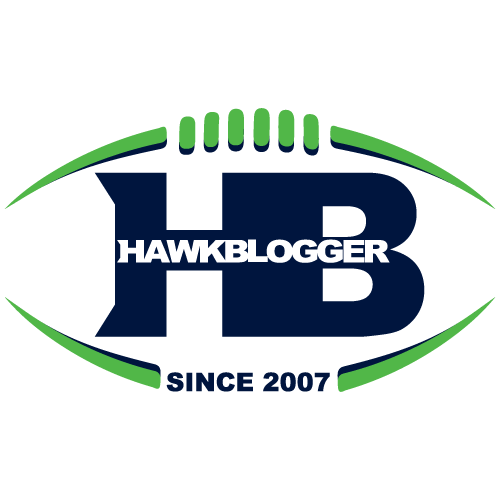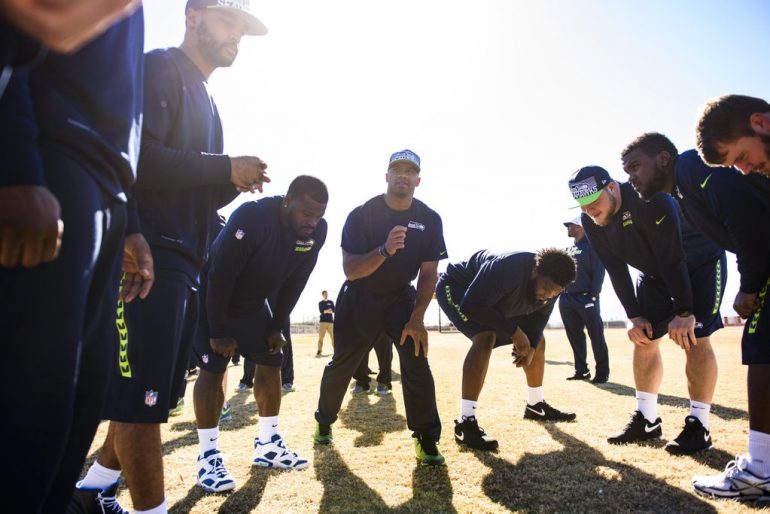[FULL ARTICLE TEXT]
Pete Carroll was giddy when the Seahawks traded back in first round of the 2012 draft and still were able to select Bruce Irvin. Carroll described Irvin as the ideal LEO pass rusher. He was long, lean, flexible and insanely fast. Seattle had drafted the heir apparent to Chris Clemons, except Clemons has now departed and Seahawks defensive coordinator Dan Quinn has indicated Irvin is not in line to step into that role. A draft that saw Bobby Wagner and Russell Wilson explode from the second and third rounds, now waits to see if the man taken in the first round can realize his vast potential.
“Ever since I have been in coaching, we’ve been looking for a guy like this.” – Pete Carroll on drafting Bruce Irvin
There is a misperception out there that Irvin was somehow unsuccessful as a rookie. He finished the regular season with 8.0 sacks and recorded another in his first playoff game against Robert Griffin III and the Redskins. Few rookie pass rushers have accomplished more, and those that have, read like a who’s who of NFL greats.
Irvin was a pass rush specialist as a rookie. He played a role that closely resembles what Cliff Avril did last year. When the base defense was on the field in early downs or clear running situations, Irvin was on the sideline. In nickel or passing situations, Irvin would line up opposite of Clemons and hunt the quarterback. By most measures, he was darn good at it. Not only did he record the 8.0 regular season sacks, but he was sixth in the NFL in quarterback pressures, according to Pro Football Focus. The combination of the two, along with a limited number of snaps made him the seventh-most productive pass rusher in the league in 2012.
Irvin rushed the passer 344 times during the regular season, second only to Clemons’ 511 attempts. It seemed like the plan was unfolding just like Carroll had hoped. And then an odd twist occurred that may have changed Irvin’s career. Clemons torn his knee near the end of the playoff game versus the Redskins, opening up the starting LEO spot for the Seahawks second-round playoff game versus the Atlanta Falcons. On it’s surface, this was a nearly ideal chance for Irvin to stake his claim to the primary pass-rushing role of the defense. The opportunity was genuine. The outcome made it seem like a mirage. Irvin finished the Falcons game, a loss, with no sacks and just one tackle. Atlanta appeared to target the undersized Irvin in blocking schemes and ran directly at him. It was not pretty.
The season ended that day, and apparently, so did Irvin’s hopes of eventually becoming Clemons’ successor at the LEO position. By the time the team returned to the field for off-season training, Irvin had been moved to linebacker. Avril and Michael Bennett were added to the pass-rushing mix, and Irvin was suspended four games for a PED violation. Just like that, the bloom was off the rose.
Carroll tried to soften the impact by emphasizing the similarities between the LEO position and the strongside linebacker (SAM) position in his defense. They largely require the same body type. The biggest difference was that the SAM dropped into coverage more and rushed the passer less. Irvin seemed pleased with the change, and even said during a radio interview he thought it may have saved his career.
That comment came rather early in the year. By the time the season had ended, Irvin had to be wondering if his best asset, his ability to get to the passer, was being utilized. His pass rush attempts dropped precipitously from his rookie year from 344 to 121. Even if you account for his four-game suspension, he went from over 20 pass rush attempts per game in 2012 to just over 10 in 2013. He dropped from second-most pass rush attempts on the team as a rookie to eighth last year. Players like Tony McDaniel, Red Bryant, Clinton McDonald and Brandon Mebane all rushed the passer more often. Carroll and Dan Quinn would likely point out to Irvin that he got the most attempts, by far, of any linebacker (Wagner and K.J. Wright were around 50 attempts). That begs the question, though, can Irvin reach his pass rush potential from his SAM role?
Irvin may have rushed the passer less in 2013, but he was on the field far more, and played very well. He was adept in coverage, strong enough to set the edge and funnel running backs inside, and a physical tackler. Of the 35 outside linebackers who played in a 4-3 defense last season, Irvin was rated #7 by ProFootballFocus. Only teammate Malcolm Smith (#5) rated higher in that group on the Seahawks.
Irvin was asked to be a pass rush specialist as a rookie, and did a remarkably good job when looking at the history of rookie pass rushers and the efficiency of his performance relative to the league. He was then asked to be a SAM linebacker as a second-year player and did a very good job at that.
Malcolm Smith won the Super Bowl MVP, and was the best weakside linebacker (WILL) on the roster last year. Wright was the starting WILL, but his best position was the SAM role that Irvin occupied last year. When the Super Bowl rolled around, Wright was back at SAM and Smith started at WILL. Irvin was back to being a pass-rush specialist, and only saw 19 snaps, his fewest of any game in the season. That, after getting 24 snaps versus the 49ers, which had been his lowest snap total to that point.
Smith and Wright both see their contracts expire after this season. Cliff Avril’s contract expires after this season. Irvin is signed through 2015, and the team can pick up his fifth-year option that would keep him in Seattle through 2016. He is the guy that the team knows will be around for a while. It is time to start molding him into the player he can be, not the player they need him to be that moment. Quinn recently reiterated that Irvin will remain at SAM. That has a trickle-down effect of meaning Wright will start again at WILL, and Smith will be left off the base defense. It is unclear who will start at LEO. There is Benson Mayowa, Cliff Avril, Michael Bennett, O’Brien Schofield and others that will vie for snaps there. Fans assuming it will be Avril are likely going to be disappointed as he is almost exclusively a strongside pass rusher and the LEO is a weakside role.
That the team is not throwing Irvin into that fray speaks volumes. It was the role he was drafted to fill, and outside of that one game versus the Falcons, he showed promise as a pass rusher.
If the coaching staff is convinced Irvin cannot be an every down defensive end, they need to find ways to get him rushing the passer more often in 2014. Irvin, Avril and Bennett should be the featured rushers, with Irvin at least doubling his pass rush attempts from last season. How they accomplish that feat with someone else getting the LEO snaps is a big question. The plan may be to let Avril walk after this year, let Irvin assume his role and use some of that money to sign a player better suited to the LEO spot. If the team signs Wright to a spendy deal after this year, he should be used at the position that best suits him, which is the same position Irvin currently plays. If the team signs Smith instead, perhaps Irvin stays right where he is.
The front office has to see all those possible futures for Irvin. It is always the goal to put the best possible team on the field, but there is also a lot of pride at the VMAC in being a great organization for developing talent. The team is doing Irvin a disservice if they keep morphing his role and change the definition of success. Carroll waited all those years to get his hands on a player with Irvin’s abilities. He has yet to find the combination that unlocks this pass-rushing Pandora’s box. Irvin is at his best when lined up with one goal in mind: destroy the quarterback. Just because he can set the edge or drop into coverage does not mean he should. Finding a great pass rusher is like unearthing a diamond. Finding a great SAM linebacker is like uncovering an amethyst. Both are valuable, but one is far more so. Seahawks coaches need to be careful about limiting the potential value of their former first-round pick.

